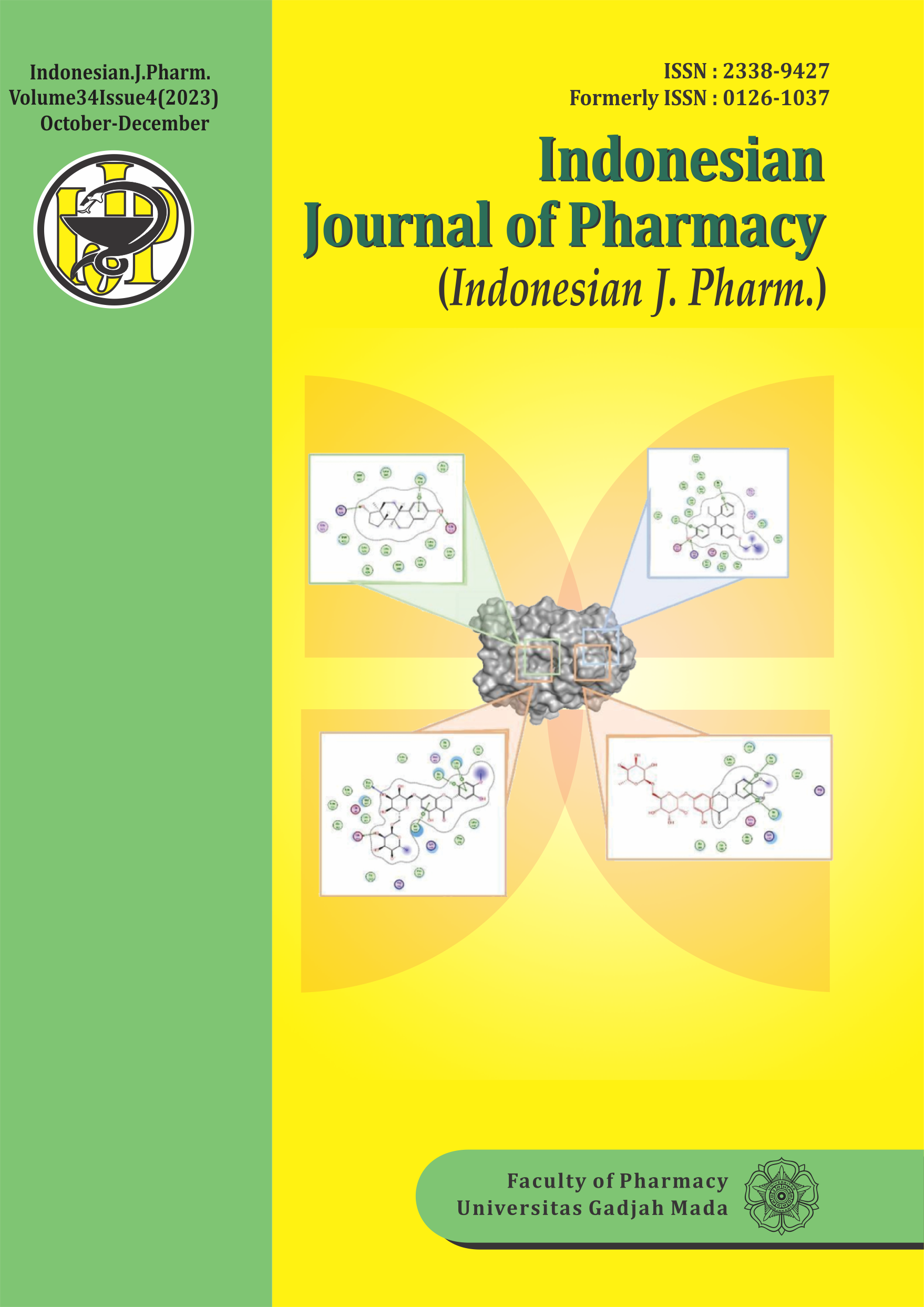Study of 1-Formyl-2-Pyrazolines as Anticancer Drug Candidates
Abstract
The development of novel anticancer agents is essential in cancer prevention. One versatile group of compounds, known for their significant bioactivity and several of its derivatives that have been clinically approved, is the group of pyrazolines. This study aimed to synthesize 1-formyl-2-pyrazoline derivatives (pyrazolines 1-2) using chalcone 1-2, hydrazine hydrate, and formic acid via cyclo-condensation. The synthesized compounds were characterized using Fourier Transform Infrared (FTIR), Gas Chromatography-Mass Spectrometry (GC-MS), and Nuclear Magnetic Resonance (1H- and 13C-NMR) spectrometers. Pyrazolines 1-2 were found to be drug-like compounds, satisfying Lipinski’s Rule of Five and possessing favourable absorption, distribution, metabolism, and excretion (ADME) properties, including good gastrointestinal absorption, blood-brain barrier permeability, and no interaction with P-glycoprotein. Furthermore, they were inactive against several toxicity endpoints in a normal body condition, such as immunotoxicity, mutagenicity, and cytotoxicity. In vitro cytotoxic evaluation of the pyrazolines 1-2 against HeLa and MCF7 cancer cell lines demonstrated moderate activity, with IC50 values of 25.01 µM and 82.87 µM, respectively. Pyrazolines 1-2 also showed good selectivity with selectivity index (SI) values of 8.92 and 14.45. The molecular docking study on epidermal growth factor receptor tyrosine kinase (EGFR-TK) (PDB ID: 4HJO) revealed that pyrazolines 1-2 had a binding affinity of -7.9 and -8.0 kcal/mol, respectively. The compounds interacted with Lys721 residue through hydrogen bonds and hydrophobic interactions due to the presence of the pyrazoline ring and the formyl group in their structures. These findings suggest that pyrazolines 1-2 scaffold has the potential to be further studied as a lead compound for anticancer drug candidates.
References
Bickerton, G. R., Paolini, G. V., Besnard, J., Muresan, S., & Hopkins, A. L. (2012). Quantifying the chemical beauty of drugs. Nature Chemistry, 4(2), 90–98. https://doi.org/10.1038/nchem.1243
Frisch, M. J., Trucks, G. W., Schlegel, H. B., Scuseria, G. E., Robb, M. A., Cheeseman, J. R., Scalmani, G., Barone, V., Petersson, G. A., Nakatsuji, H., Li, X., Caricato, M., Marenich, A. V., Bloino, J., Janesko, B. G., Gomperts, R., Mennucci, B., Hratchian, H. P., Ortiz, J. V., Izmaylov, A. F., Sonnenberg, J. L., Williams-Young, D., Ding, F., Lipparini, F., Egidi, F., Goings, J., Peng, B., Petrone, A., Henderson, T., Ranasinghe, D., Zakrzewski, V. G., Gao, J., Rega, N., Zheng, G., Liang, W., Hada, M., Ehara, M., Toyota, K., Fukuda, R., Hasegawa, J., Ishida, M., Nakajima, T., Honda, Y., Kitao, O., Nakai, H., Vreven, T., Throssell, K., Montgomery, J. A., Jr., Peralta, J. E., Ogliaro, F., Bearpark, M. J., Heyd, J. J., Brothers, E. N., Kudin, K. N., Staroverov, V. N., Keith, T. A., Kobayashi, R., Normand, J., Raghavachari, K., Rendell, A. P., Burant, J. C., Iyengar, S. S., Tomasi, J., Cossi, M., Millam, J. M., Klene, M., Adamo, C., Cammi, R., Ochterski, J. W., Martin, R. L., Morokuma, K., Farkas, O., Foresman, J. B., & Fox, D. J. (2016). Gaussian, Inc., Wallingford CT.
Haider, K., Shafeeque, M., Yahya, S., & Yar, M. S. (2022). A comprehensive review on pyrazoline based heterocyclic hybrids as potent anticancer agents. European Journal of Medicinal Chemistry Reports, 5, 100042. https://doi.org/10.1016/J.EJMCR.2022.100042
Hollenberg, P. F. (2002). Characteristics and common properties of inhibitors, inducers, and activators of CYP enzymes. Drug Metabolism Reviews, 34(1&2), 17-35. https://doi.org/10.1081/dmr-120001387
Indrayanto, G., Putra, G. S., & Suhud, F. (2021). Validation of in-vitro bioassay methods: Application in herbal drug research. In Profiles of Drug Substances, Excipients, and Related Methodology, 46, (pp. 273–307). https://doi.org/10.1016/bs.podrm.2020.07.005
Karabacak, M., Altıntop, M. D., Çiftçi, H. İ., Koga, R., Otsuka, M., Fujita, M., & Özdemir, A. (2015). Synthesis and evaluation of new pyrazoline derivatives as potential anticancer agents. Molecules, 20, 19066-19084. https://doi.org/10.3390/molecules201019066
Li, J., Ma, C., Huang, Y., Luo, J., & Huang, C. (2003). Differential requirement of EGF receptor and its tyrosine kinase for AP-1 transactivation induced by EGF and TPA. Oncogene, 22(2), 211–219. https://doi.org/10.1038/sj.onc.1206102
Mitsudomi, T., & Yatabe, Y. (2010). Epidermal growth factor receptor in relation to tumor development: EGFR gene and cancer. The FEBS Journal, 277(2), 301–308. https://doi.org/10.1111/j.1742-4658.2009.07448.x
Mustofa, Satriyo, P. B., Suma, A. A. T., Waskitha, S. S. W., Wahyuningsih, T. D., & Sholikhah, E. N. (2022). A potent EGFR inhibitor, N-phenyl pyrazoline derivative suppresses aggressiveness and cancer stem cell-like phenotype of cervical cancer cells. Drug Design, Development and Therapy, 16, 2325–2339. https://doi.org/10.2147/DDDT.S350913
Ramírez, D., & Caballero, J. (2018). Is it reliable to take the molecular docking top scoring position as the best solution without considering available structural data? Molecules, 23(5), 1038. https://doi.org/10.3390/molecules23051038
Rana, M., Faizan, M. I., Dar, S. H., Ahmad, T., & Rahisuddin. (2022). Design and synthesis of carbothioamide/carboxamide-based pyrazoline analogs as potential anticancer agents: apoptosis, molecular docking, ADME assay, and DNA binding studies. ACS Omega, 7(26), 22639–22656. https://doi.org/10.1021/acsomega.2c02033
Suma, A. A. T., Wahyuningsih, T. D., & Mustofa. (2019). Synthesis, cytotoxicity evaluation and molecular docking study of N-phenylpyrazoline derivatives. Indonesian Journal of Chemistry, 19(4), 1081–1090. https://doi.org/10.22146/ijc.45777
Suma, A. A. T., Wahyuningsih, T. D., & Pranowo, D. (2017). Synthesis and antibacterial activities of N-phenylpyrazolines from veratraldehyde. Materials Science Forum, 901, 124–132. https://doi.org/10.4028/www.scientific.net/MSF.901.124
Sung, H., Ferlay, J., Siegel, R. L., Laversanne, M., Soerjomataram, I., Jemal, A., & Bray, F. (2021). Global cancer statistics 2020: GLOBOCAN estimates of incidence and mortality worldwide for 36 cancers in 185 countries. CA: A Cancer Journal for Clinicians, 71(3), 209–249. https://doi.org/10.3322/caac.21660
Trott, O., & Olson, A. J. (2010). AutoDock Vina: Improving the speed and accuracy of docking with a new scoring function, efficient optimization, and multithreading. Journal of Computational Chemistry, 31, 455-461. https://doi.org/10.1002/jcc.21334
Vahedpour, T., Hamzeh‐Mivehroud, M., Hemmati, S., & Dastmalchi, S. (2021). Synthesis of 2‐pyrazolines from hydrazines: Mechanisms explained. ChemistrySelect, 6(25), 6483–6506. https://doi.org/10.1002/slct.202101467
Wahyuningsih, T. D., Suma, A. A. T., & Astuti, E. (2019). Synthesis, anticancer activity, and docking study of N-acetyl pyrazolines from veratraldehyde. Journal of Applied Pharmaceutical Science, 9(3), 14–20. https://doi.org/10.7324/JAPS.2019.90303
Weerapreeyakul, N., Nonpunya, A., Barusrux, S., Thitimetharoch, T., & Sripanidkulchai, B. (2012). Evaluation of the anticancer potential of six herbs against a hepatoma cell line. Chinese Medicine, 7(1), 15. https://doi.org/10.1186/1749-8546-7-15








